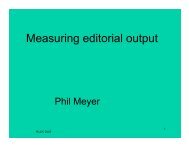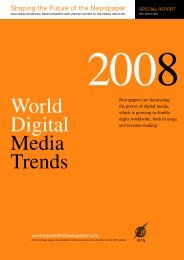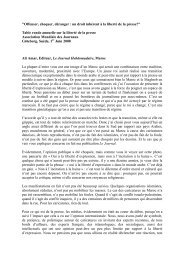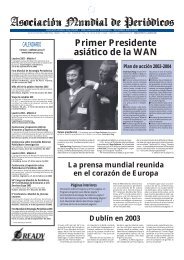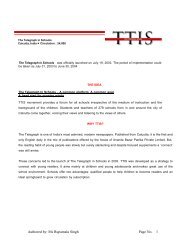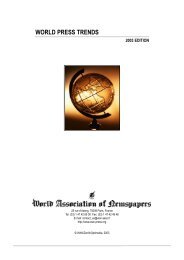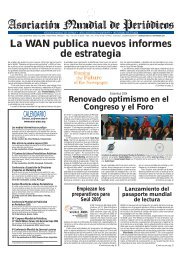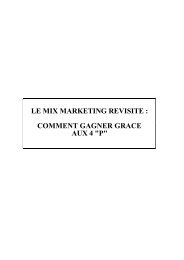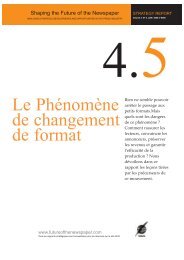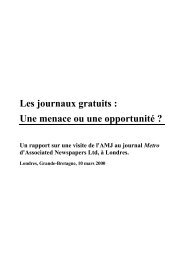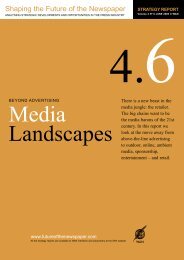MEDIA MARKET DATA - World Association of Newspapers
MEDIA MARKET DATA - World Association of Newspapers
MEDIA MARKET DATA - World Association of Newspapers
You also want an ePaper? Increase the reach of your titles
YUMPU automatically turns print PDFs into web optimized ePapers that Google loves.
400,000. If we consider that each paper is read by four people, only 3% <strong>of</strong> Lebaneseindividuals buy a newspaper and only 8% read one, out <strong>of</strong> a total <strong>of</strong> 4 million. Perhaps itsuffices to consult the statistics published by Arab Ad, a monthly magazine focused on thelatest developments in the field <strong>of</strong> communication and business, in its February 2005 issue,examining the number <strong>of</strong> advertisements featured in Lebanese newspapers between 1997 and2004, in conjunction with IPSOS STAT. The study showed a worrying decrease in adrevenues from $36 million to $28 million. Experts disagree on the causes <strong>of</strong> this downturn,with some blaming the newspapers themselves for the public’s lack <strong>of</strong> confidence in printpublications as they follow the example <strong>of</strong> Lebanese politicians and forge alliances motivatedby financial gain, thereby hurting their credibility. Others believe the crisis is caused by thepopulation’s boredom and the lack <strong>of</strong> loyalty to newspapers. During the golden age <strong>of</strong>newspapers in Lebanon, before the civil war started in 1975, newspapers used to sell 400thousand copies a day, according to Naji Tueini, deputy general manager <strong>of</strong> An Nahar. Heblamed the dismal economic conditions in Lebanon and the pressures <strong>of</strong> modern life for thedecline in newspaper readership, with many working longer hours. Tueini recalled a timewhen An Nahar used to print more than 110 thousand copies, or more copies that all 14newspapers put together! Issam Rahil, head <strong>of</strong> advertising at al Mustaqbal, agreed withTueini’s diagnosis but added another dimension to the crisis: the entrenchment <strong>of</strong>sectarianism in Lebanon . He indicated that no national newspapers existed in the country;instead, newspapers spoke on behalf <strong>of</strong> a sect or a region inhabited by a sect. For example, inthe Shiaa south, As Safir was popular while in Sunni Tripoli, al Mustaqbal was the preferreddaily and in Christian areas, An Nahar was the best-selling newspaper. This, he added, wasnormal due to Lebanon ’s sectarian make-up. For his part, Sami Mashaqah, director <strong>of</strong>distribution at As Safir, said the political orientation <strong>of</strong> a newspaper can, at times, correspondto that <strong>of</strong> the population in a certain area, citing As Safir’s popularity in south Lebanon , theBekaa valley, Beirut and Tripoli , compared to eastern Beirut and Kesrwan. All three <strong>of</strong>ficialsagreed that the internet and specialist television channels had not affected the popularity <strong>of</strong>newspapers in Lebanon . Mashaqah said consumers could not afford the latest technologiesand Rahil added that it was difficult to read a newspaper online because the reader wouldhave to focus at his or her screen for a prolonged period <strong>of</strong> time. TV news channels played apositive role because they encouraged viewers to consult a newspaper to find out the details<strong>of</strong> a political event, according to Tueini. Ibrahim al Amni, who is about to publish his ownpolitical daily, said he was conducting studies in order to overcome the difficulties faced byother newspaper. It was useful, he added, to consider the example <strong>of</strong> Sada al Balad, publisheda few years ago. Between the realities <strong>of</strong> the Lebanese press and the ambitions <strong>of</strong> its editors,newspapers have realized the depth <strong>of</strong> the problem and launched this preliminary campaign.<strong>Newspapers</strong> find themselves faced with a critical test: can they survive? Only time will tell.http://aawsat.com/english/news.asp?section=5&id=4948; May 15, 2006Subscription / LoyaltyKorea, Republic <strong>of</strong>The Chosun Ilbo remains Korea’s favorite newspaper, a government survey released Mondayfinds. The Local Press Committee said a survey <strong>of</strong> households subscribing to newspapersshowed that the biggest group or 13.6 percent took the Chosun Ilbo. The JoongAng Ilbo camesecond with 11.1 percent, followed by the DongA Ilbo with 10 percent, the HankyorehShinmun and Maeil Business Newspaper with 2 percent each, and the Busan Ilbo with 1.8percent. Out <strong>of</strong> total circulation delivered to doorsteps nationwide including homes that tookmore than one paper, the Chosun Ilbo took 25.8 percent. It was followed by the JoongAng48



